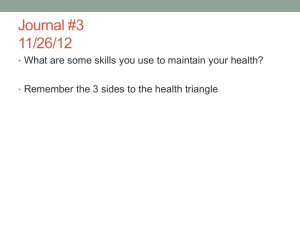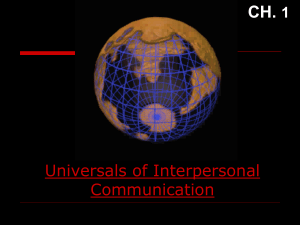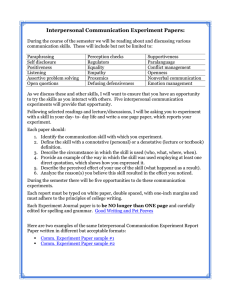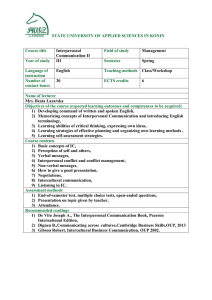COMM-7 (if applicable): Interpersonal Communication
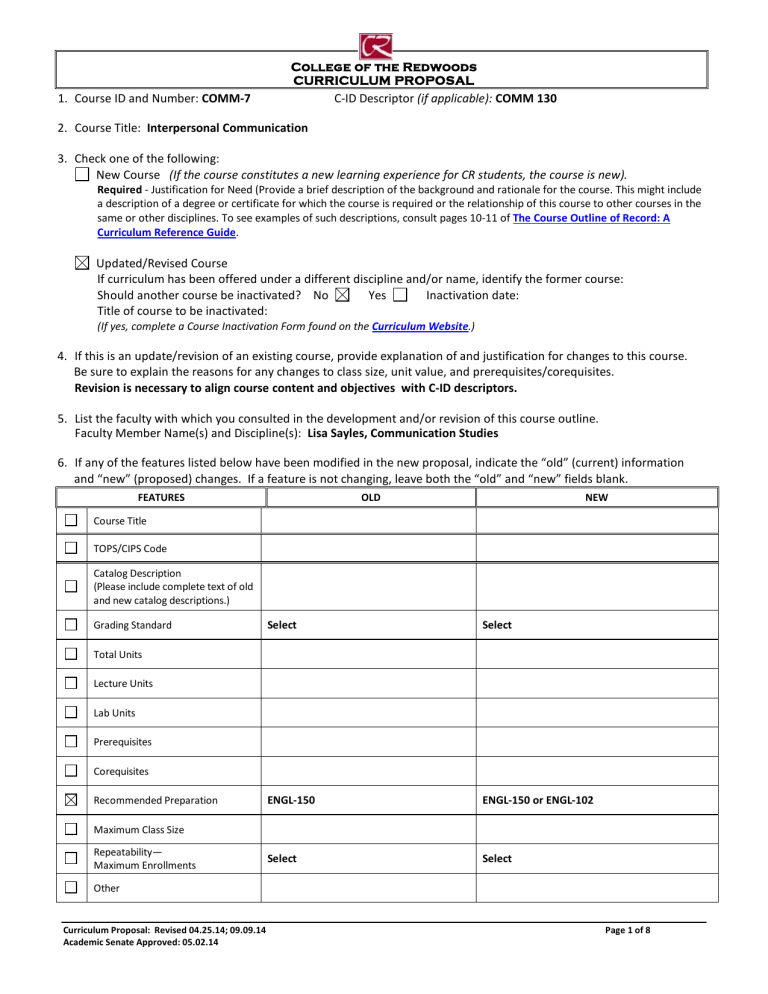
College of the Redwoods
CURRICULUM PROPOSAL
1.
Course ID and Number: COMM-7
2.
Course Title: Interpersonal Communication
C-ID Descriptor (if applicable): COMM 130
3.
Check one of the following:
New Course (If the course constitutes a new learning experience for CR students, the course is new).
Required - Justification for Need (Provide a brief description of the background and rationale for the course. This might include a description of a degree or certificate for which the course is required or the relationship of this course to other courses in the same or other disciplines. To see examples of such descriptions, consult pages 10-11 of The Course Outline of Record: A
Curriculum Reference Guide .
Updated/Revised Course
If curriculum has been offered under a different discipline and/or name, identify the former course:
Should another course be inactivated? No Yes Inactivation date:
Title of course to be inactivated:
(If yes, complete a Course Inactivation Form found on the Curriculum Website .)
4.
If this is an update/revision of an existing course, provide explanation of and justification for changes to this course.
Be sure to explain the reasons for any changes to class size, unit value, and prerequisites/corequisites.
Revision is necessary to align course content and objectives with C-ID descriptors.
5.
List the faculty with which you consulted in the development and/or revision of this course outline.
Faculty Member Name(s) and Discipline(s): Lisa Sayles, Communication Studies
6.
If any of the features listed below have been modified in the new proposal, indicate the “old” (current) information and “new” (proposed) changes. If a feature is not changing, leave both the “old” and “new” fields blank.
FEATURES OLD NEW
Course Title
TOPS/CIPS Code
Catalog Description
(Please include complete text of old and new catalog descriptions.)
Grading Standard Select Select
Total Units
Lecture Units
Lab Units
Prerequisites
Corequisites
Recommended Preparation ENGL-150
Maximum Class Size
Repeatability—
Maximum Enrollments
Other
Curriculum Proposal: Revised 04.25.14; 09.09.14
Academic Senate Approved: 05.02.14
Select
ENGL-150 or ENGL-102
Select
Page 1 of 8
1.
DATE: 10/28/15
2.
DIVISION : Arts and Humanities
3.
4.
[CB04] COURSE CREDIT STATUS: D Credit-Degree Applicable
[CB01] COURSE ID AND NUMBER: COMM-7
5.
6.
7.
[CB02] COURSE TITLE: Interpersonal Communication
(Course title appears in Catalog and schedule of classes.)
SHORT TITLE: Interpersonal Comm
(Short title appears on student transcripts and is limited to 30 characters, including spaces.)
[CB03] LOCAL ID (TOPs code): 150600 Taxonomy of Program Codes
NATIONAL ID (CIP code): 23.1001
Classification of Instructional Program Codes 8.
9.
DISCIPLINE(S): Communication Studies (Speech Communication) Select from Minimum Qualifications for Faculty
Course may fit more than one discipline; identify all that apply:
10.
FIRST TERM NEW OR REVISED COURSE MAY BE OFFERED: Spring 2016
11.
COURSE UNITS (Note: 1 lecture unit requires 18 hours in-class/36 hours out-of-class; 1 lab unit requires 54 in-class hours)
TOTAL UNITS:
TOTAL HOURS:
[CB07]
3 min. units
54 min. hours
11. MAXIMUM CLASS SIZE: 30
[CB06]
3 max. units
54 max. hours
Lecture Units:
Lecture Hours:
3
54
Lab Units:
Lab Hours:
0
0
12.
WILL THIS COURSE HAVE AN INSTRUCTIONAL MATERIALS FEE? No Yes Fee: $
If yes, attach a completed Instructional Materials Fee Request Form found on the Curriculum Website .
GRADING STANDARD
Letter Grade Only Pass/No Pass Only Grade-Pass/No Pass Option
[CB12] Is this course a repeatable lab course? No Yes If yes, how many total enrollments?
Select
Is this course to be offered as part of the Honors Program?
No Yes
If yes, explain how honors sections of the course are different from standard sections.
CATALOG DESCRIPTION - The catalog description should clearly describe for students the scope of the course, its level, and
what kinds of student goals the course is designed to fulfill. The catalog description should begin with a sentence fragment.
An introductory survey communication course designed to increase interpersonal awareness and effectiveness in person-to-person communication settings. Students will read, discuss, and apply concepts and principles while developing skills dealing with the verbal and nonverbal transactions that occur in relationships.
Special Notes or Advisories (e.g. Field Trips Required, Prior Admission to Special Program Required, etc.) :
PREREQUISITE COURSE(S)
No Yes Course(s):
Rationale for Prerequisite:
Describe representative skills without which the student would be highly unlikely to succeed.
COREQUISITE COURSE(S)
No Yes Course(s):
Curriculum Proposal: Revised 04.25.14; 09.09.14
Academic Senate Approved: 05.02.14
Page 2 of 8
Rationale for Corequisite:
RECOMMENDED PREPARATION
No Yes Course(s): English 150 or English 102
Rationale for Recommended Preparation:
Because this course carries with it CSU equivalent transfer units, students must be able to meet college-level reading and writing standards to successfully complete this course
COURSE LEARNING OUTCOMES – This section answers the question “what will students be able to do as a result of taking this course?” State some of the outcomes in terms of specific, measurable student actions (e.g. discuss, identify, describe, analyze, construct, compare, compose, display, report, select, etc.). For a more complete list of outcome verbs please see Public
Folders>Curriculum>Help Folder>SLO Language Chart. Each outcome should be numbered.
1. Identify ethical, competent, and incompetent verbal and nonverbal communication behaviors.
2. Explain the relationship between self-concept and communication.
3. Analyze how communication affects relational dynamics.
4. Describe the role of perceptual frameworks in interpersonal communication.
COURSE OBJECTIVES - This section describes the objectives the course addresses through the course content. Objectives can include specific disciplinary questions or goals that are central to the course subject matter and are meant to address what the various intents of the course are. Each objective should be numbered.
1. Describe ways that communication creates, develops, and changes personal identities including variables such as culture, gender, ethnicity, and race.
2. Explain the effect of communication on personal identities.
3. Demonstrate an understanding of ethical interpersonal communication founded on current communication theory and research.
4. Recognize conflict in interpersonal relationships and demonstrate appropriate, ethical conflict resolution methods.
5. Demonstrate effective listening skills.
6. Adapt communication strategies to meet the needs of the situation, the relational partner, and individual goals.
7. Identify communication skills that contribute to effective interpersonal relationships.
8. Describe the effects of communication on interpersonal realtionships and social and cultural realities.
METHODS OF INSTRUCTION – Clear methods by which instructor will facilitate acquisition of objectives. Include here descriptions, NOT lists. Course outline must clearly articulate how these methods of instruction are related to, and help student work towards, achieving the objectives and student learning outcomes. Instructional methodologies will be consistent with, but will not be limited to, the following types orexamples.
Lectures will utilize supporting materials (including both historical and current examples) to illustrate key theories and key concepts. Small and large group discussions will challenge students to articulate their understanding of course material and to analyze issues relevant to interpersonal communication. Group projects concerning issues of historical, current, and/or future import will ask students to research issues and critically evaluate information relative to interpersonal communication concepts. Individual projects outside of class time will ask students to research aspects of interpersonal communication and to analyze and reflect on their own communicative behaviors.
COURSE CONTENT –This section describes what the course is “about”-i.e. what it covers and what knowledge students will acquire.
Concepts: What terms and ideas will students need to understand and be conversant with as they demonstrate course outcomes? Each concept should be numbered.
1. Theories and principles of interpersonal communication.
2. The role of perception in the delivery and reception of messages.
3. The role of language (verbal and non-verbal) in the delivery and reception of messages.
4. The role of culture and gender in communication competence.
5. The process of identity construction, negotiation, and management.
6. Relational dynamics.
7. Ethical interpersonal communication.
8. Conflict negotiation and management.
9. Interpersonal communication in various contexts, including personal and professional.
Issues: What primary tensions or problems inherent in the subject matter of the course will students engage? Each issue
Curriculum Proposal: Revised 04.25.14; 09.09.14
Academic Senate Approved: 05.02.14
Page 3 of 8
should be numbered.
1. Gender as a variable in the communication context.
2. Diversity (gender, ethnicity, ability, socio-economic status, sexual identity, etc.) as a factor and a confounding variable in the communication context.
3. Multiculturalism and its role in understanding and practicing interpersonal communication.
4. Individual perceptual biases as a barrier to interpersonal communication competence.
Themes: What motifs, if any, are threaded throughout the course? Each theme should be numbered.
1. The role of communication theory in developing cognitive complexity as a means to increase interpersonal communication competence.
Skills: What abilities must students have in order to demonstrate course outcomes? (E.g. write clearly, use a scientific calculator, read college-level texts, create a field notebook, safely use power tools, etc). Each skill should be numbered.
1. Practice perspective-taking and "other" orientation development.
2. Demonstrate critical and empathic listening techniques.
3. Negotiate identities and meanings.
4. Develop ethical and responsible conflict negotiation and problem ownership skills while distinguishing among various language techniques.
5. Practice rhetorical sensitivity in multicultural or diverse settings.
6. Identify factors that affect perception.
7. Demonstrate nonverbal behaviors and support and do not support verbal messages.
8. Analyze self-concept and communication to more effectively manage identity.
REPRESENTATIVE LEARNING ACTIVITIES –This section provides examples of things students may do to engage the course content (e.g., listening to lectures, participating in discussions and/or group activities, attending a field trip). These activities should relate directly to the Course Learning Outcomes. Each activity should be numbered.
1. Listening to lectures.
2. Critically reading, watching, and analyzing textual material outside of class.
3. Participating in discussions and group activities (both in and out of class) and/or developing and presenting group projects/presentations.
4. Practicing, illustrating, and explaining the relative effectiveness of certain communication concepts or skills during in-class discussions, exercises, or via an ongoing journal.
5. Illustrating how communication choices in differing circumstances may bring about different outcomes.
6. Researching interpersonal communication theories/concepts outside of class.
ASSESSMENT TASKS –This section describes assessments instructors may use to allow students opportunities to provide evidence of achieving the Course Learning Outcomes. Each assessment should be numbered.
Representative Assessment Tasks (These are examples of assessments instructors could use.):
1. Group projects.
2. Presentations and/or group presentations.
3. Article abstracts.
4. Annotated bibliographies.
5. Research papers.
Required Assessments for All Sections (These are assessments that are required of all instructors of all sections at all campuses/sites. Not all courses will have required assessments. Do not list here assessments that are listed as representative
assessments above.):
1. Exams.
2. Quizzes.
3. Writing assignments (papers or journaling).
EXAMPLES OF APPROPRIATE TEXTS OR OTHER READINGS –This section lists example texts, not required texts.
Author, Title, and Date Fields are required
Author Adler & Proctor Title Looking Out, Looking In Date 2014
Author Wood Title Interpersonal Communication: Everyday Encounters Date 2013
Author West & Turner Title Understanding Interpersonal Communication Date 2011
Curriculum Proposal: Revised 04.25.14; 09.09.14
Academic Senate Approved: 05.02.14
Page 4 of 8
Author Title Date
Other Appropriate Readings:
COURSE TYPES
1.
Is the course part of a Chancellor’s Office approved CR Associate Degree ? No Yes
If yes, specify all program codes that apply. (Codes can be found in Outlook/Public Folders/All Public Folders/
Curriculum/Degree and Certificate Programs/choose appropriate catalog year):
Required course for degree(s) DA.AS; MA.AS
2.
Restricted elective for degree (s)
Restricted electives are courses specifically listed (i.e. by name and number) as optional courses from which students may choose to complete a specific number of units required for an approved degree.
Is the course part of a Chancellor’s Office approved CR Certificate of Achievement ? No Yes
If yes, specify all program codes that apply. (Codes can be found in Outlook/Public Folders/All Public Folders/
Curriculum/Degree and Certificate Programs/choose appropriate catalog year):
Required course for certificate(s) DA.CA
Restricted elective for certificate(s)
Restricted electives are courses specifically listed (i.e. by name and number) as optional courses from which students may choose to complete a specific number of units required for an approved certificate.
3.
4.
5.
[CB24] Is the course Stand Alone? No Yes (If “No” is checked for
BOTH #1 & #2 above, the course is stand alone.)
[CB08] Basic Skills: NBS Not Basic Skills
[CB10] Work Experience: NWE Not Coop Work Experience
[CB22] Noncredit Category: Credit course, not applicable 6.
7.
8.
9.
Course eligible Career Technical Education funding (applies to vocational and tech-prep courses only): No Yes
[CB23] Course developed using a Chancellor’s Office Economic Development Grant: No Yes
[CB11] Purpose : Y Credit Course Course Classification Status
10.
Accounting Method: W Weekly Census
11.
[CB13] Disability Status : N Not a Special Class
12.
[CB09] Course SAM Priority Code: E Not Occupational Definitions of SAM Priority Codes
COURSE TRANSFERABILITY
1.
[CB05] Current Transferability Status: A Transferable to both UC and CSU
2.
[CB21] Course Prior to Transfer Level: Y Not Applicable Definitions of Course Prior to Transfer Levels
CURRENT TRANSFERABILITY STATUS (Check at least one box below):
This course is currently transferable to:
Neither CSU nor UC
CSU as general elective credit
CSU as a specific course equivalent (see below)
If the course transfers as a specific course equivalent give course number(s)/ title(s) of one or more currently-active, equivalent
lower division courses from CSU.
1. Course COM 213 , Campus HSU 2.
Course , Campus
UC as general elective credit
UC as specific course equivalent
If the course transfers as a specific course equivalent give course number(s)/ title(s) of one or more currently-active, equivalent
Curriculum Proposal: Revised 04.25.14; 09.09.14
Academic Senate Approved: 05.02.14
Page 5 of 8
lower division courses from UC.
1. Course , Campus 2.
Course , Campus
PROPOSED CSU TRANSFERABILITY (Check at least one of the boxes below):
No Proposal
Remove as General Education
Propose as General Elective Credit
Propose as a Specific Course Equivalent (see below)
If specific course equivalent credit is proposed, give course number(s)/ title(s) of one or more currently-active, equivalent lower
division courses from CSU.
1. Course , Campus 2.
Course , Campus
PROPOSED UC TRANSFERABILITY (Check one of the boxes below):
No Proposal
Remove as General Education
Propose as General Elective Credit OR Specific Course Equivalent (fill in information below)
If “General Elective Credit OR Specific Course Equivalent” box above is checked, give course number(s)/ title(s) of one or more currently-active, equivalent lower division courses from UC.
1. Course CMN 3 , Campus UC Davis 2.
Course , Campus
CURRENTLY APPROVED GENERAL EDUCATION (Check at least one box below):
CR
Not currently approved
CSU
CR GE Category(-ies): Area D2: Oral Communication, Secondary GE Category (if applicable)
CSU GE Category: A1
IGETC IGETC Category:
PROPOSED CR GENERAL EDUCATION (Check at least one box below):
No Proposal
Remove as General Education
Review to maintain CR GE Status
New GE Proposal
_X __ _ Approved as CR GE by Curriculum Committee: _12.11.15
_
_ ___ _ Not Approved
_ ___ _ Approved to remove CR GE status
CR GE Outcomes
GE learning outcomes in Effective Communication, Critical Thinking, and Global Awareness must be addressed in all general education courses. o
Effective Communications: Explain how the proposed GE course fulfills at least one of the CR GE outcomes in this category.
Course meets CR's GE outcome regarding effective communication in that it asks students to: focus on analyzing communication behaviors in order to assess their potential for increasing communication competence/incompetence, to communicate complex ideas orally and in writing; to conduct research relevant to the study of human communication; and to analyze and adapt communications on the basis of relational partner, communication context, and interpersonal goals. Course "Themes" relevant to effective communication include: The role of communication theory in developing cognitive complexity as a means to increase interpersonal communication competence. Course learning outcomes that address effective communication include: 1. Identify competent and incompetent verbal and nonverbal communication behaviors. 2. Explain the relationship between self-concept and communication. 3.Analyze how communication affects relational dynamics. o
Critical Thinking: Explain how the proposed GE course fulfills at least one of the CR GE outcomes in this category.
The course focuses on analysis of communication behaviors (of self and others) to increase interpersonal communication competence in diverse environments. Students must analyze potential communication strategies, determine the most appropriate strategies, and then operationalize effective communication behaviors within changing environments. Course asks students to evaluate relational dynamics, apply current communication theory, analyze communication behaviors and strategies, and negotiate identites and meanings.
Course "Skills" that foster critical thinking include: practice perspective taking and "other" orientation
Curriculum Proposal: Revised 04.25.14; 09.09.14
Academic Senate Approved: 05.02.14
Page 6 of 8
development, demonstrate critcal and empathic listening techniques, develop responsible conflict negotiation and problem ownership skills while distinguishing among various language techniques, and analyze communication to more effectively manage identity. Course learning outcomes that address issues of critical thinking include: identify competent and incompetent verbal and nonverbal communication behaviors; and analyze how communication affects relational dynamics. o
Global Awareness: Explain how the proposed GE course fulfills at least one of the CR GE outcomes in this category.
Rhetorical sensitivity, diversity, and intercultural communication concepts are integral aspects of modern interpersonal communication studies and are reflected in the course content. Course asks students to analyze communication behaviors from multiple perspectives and express awareness of cultures in a diverse global community. This is reflected in the "Concepts" identified for the course in the following area: the role of culture and gender on communication competence; and in the "Issues" that students must understand to sucessfully achieve course outcomes which include: Gender as a variable in the communication context; diversity as a factor and a confounding variable in the communication context; multi-culturalism and its role in understanding and practice of interpersonal communication; and individual perceptual biases as a barrier to interpersonal communication competence.
GE Criteria for Breadth and Generality
GE courses should be broad and general in scope. Typically such courses are introductory-- not advanced or specialized— and the content encompasses a broad spectrum of knowledge within a given field of study.
Explain how the proposed GE course fulfills GE criteria for breadth and generality.
Interpersonal Communication is an introductory, survey course that provides students with a broad view of research and practice in interpersonal communication.
CR GE Area Designation
Course Learning Outcomes and Course Content should provide evidence of appropriate GE Area Designation.
Additional rationale for GE Area Designation (optional):
Area A: Natural Science
Area B: Social Science
Area C: Humanities
Area D: Language and Rationality
D1: Writing
D2: Oral Communications
D3: Analytical Thinking
Area E: Multicultural Understanding*
*To be considered part of CR GE Area E, all courses must meet the following two conditions: 1. The course must also be (or be proposed) in one other CR GE area AND 2. The course must be articulated with HSU as meeting their lower-division Diversity and Common Ground GE requirement.
PROPOSED CSU GENERAL EDUCATION BREADTH (CSU GE) (Check at least one box below):
NO PROPOSAL
A. Communications and Critical Thinking
A1 – Oral Communication
A2 – Written Communication
A3 – Critical Thinking
C. Arts, Literature, Philosophy, and Foreign Language
C1 – Arts (Art, Dance, Music, Theater)
C2 – Humanities (Literature, Philosophy, Foreign
Language)
B. Science and Math
B1 – Physical Science
B2 – Life Science
B3 – Laboratory Activity
B4 – Mathematics/Quantitative Reasoning
D. Social, Political, and Economic Institutions
D0 – Sociology and Criminology
D1 – Anthropology and Archeology
D2 – Economics
D3 – Ethnic Studies
D5 – Geography
D6 – History
Curriculum Committee Approved: 04.25.14; 09.01.14
Academic Senate Approved: 05.02.14
Page 7 of 8
E. Lifelong Understanding and Self-Development
E1 – Lifelong Understanding
E2 – Self-Development
D7 – Interdisciplinary Social or Behavioral Science
D8 – Political Science, Government and Legal Institutions
D9 – Psychology
Rationale for inclusion in this General Education category: Same as above
Proposed Intersegmental General Education Transfer Curriculum (IGETC) (Check at least one box below):
NO PROPOSAL
1A – English Composition
1B – Critical Thinking-English Composition
1C – Oral Communication (CSU requirement only)
2A – Math
3A – Arts
3B – Humanities
4A – Anthropology and Archaeology
4B – Economics
4E – Geography
4F – History
4G – Interdisciplinary, Social & Behavioral Sciences
4H – Political Science, Government & Legal Institutions
4I – Psychology
4J – Sociology & Criminology
5A – Physical Science
5B – Biological Science
6A – Languages Other Than English
Rationale for inclusion in this General Education category: Same as Above
Submitted By: Kerry Mayer
Dean/Director: Erin Wall
Tel. Ext.: 4326 Date: October 28, 2015
Review Date: November 10, 2015
For Dean/Director only: Does this course change require a substantial or nonsubstantial change to a degree? Yes No
C URRICULUM C OMMITTEE U SE O NLY
Approved by Curriculum Committee: No Yes Date: 12.11.15
Academic Senate Approval Date : 12.14.15 Board of Trustees Approval Date:
Curriculum Committee Approved: 04.25.14; 09.01.14
Academic Senate Approved: 05.02.14
Page 8 of 8
